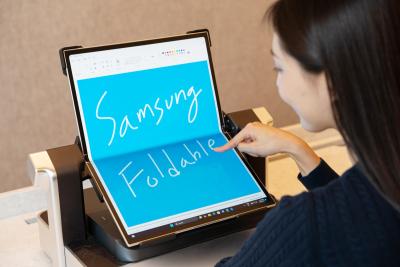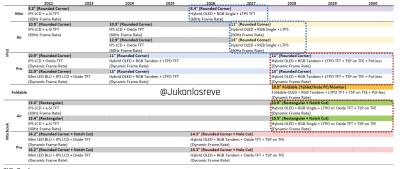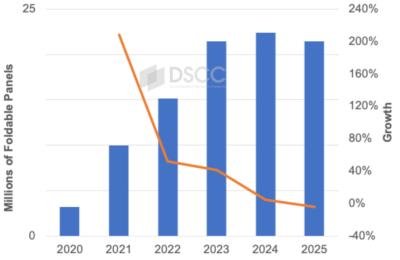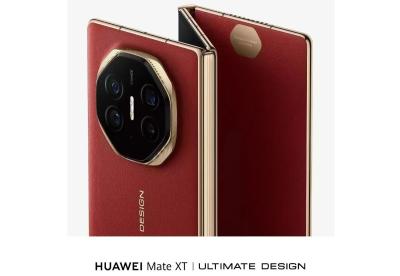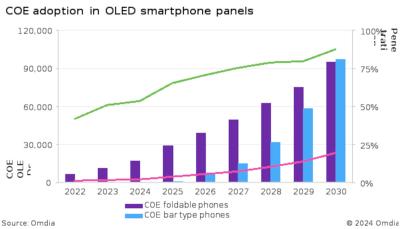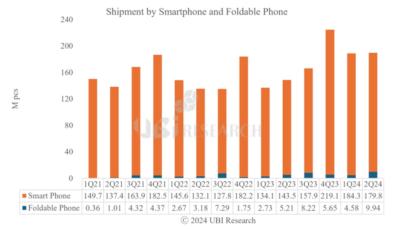Foldable OLEDs: introduction and market status
Foldable OLED displays can be bent by the user. These innovative displays enable new form factors, such as - such as phones that open into tablets, smart bands that open into smartphones and laptops with large displays. In 2019 the first foldable smartphones were launched, and after a rocky start, device markers are now introducing new devices to market as analysts expect increased adoption in the future.

Foldable smartphones
In 2019 Samsung finally introduced the first device, the Galaxy Fold - which had a problematic launch. Since then Samsung followed up with several new foldable phones, for example the Galaxy Z Fold 2 which sports an internal foldable display at 7.6" 1768x2208 HDR10+ 120Hz Dynamic AMOLED and also a larger 6.23" 816x2260 Super AMOLED cover display. Samsung also launched the clamshell-style Galaxy Z Flip.
Several companies offer foldable phones besides Samsung, including Motorola, Huawei and others. Huawei for example launched the Mate X2 in 2021, which features an inside-folding AMOLED display, a 8-inch 90Hz 2480 x 2200 one. There is also an external 6.45-inch 1160 x 2700 90Hz (240Hz touch sampling rate) AMOLED display.

Foldable OLED laptops
Foldable OLED laptops is another promising market segment. In 2021 Lenovo started shipping the $2,499 foldable ThinkPad X1 Fold laptop, with its 13.3" 2048x1536 foldable OLED display (produced by LG Display). Hopefully more companies will follow suit and we'll see more such devices on the market soon. In 2023, HP announced the Spectre Foldable PC, based on a 17" 2560x1920 foldable OLED display.

Samsung Display shows new OLED technologies at CES 2025
Samsung Display is set to show new OLED technologies at CES 2025, including new foldable display, rollable ones, automotive displays, next-gen QD-OLED panels and more.
So first up, Samsung will be showing a 18.1 foldable OLED display (which it says is the world's largest). This panel is suitable for IT devices - to enable devices that combine tablet, laptop and monitor devices into one. When folded, this display is 13.1" in size.
Omdia updates its Apple laptop and tablet adoption forecast, with new devices arriving in 2026 - and Apple's first foldable laptop by 2028
Omdia has updated its Apple iPad and Macbook display roadmaps, with new forecasts and information about Apple's OLED adoption plans in its IT product lines.
According to Omdia, Apple's iPad Mini will get a 8.4-inch LTPS OLED display in 2026. In 2027, Apple will also introduce OLED displays in its iPad Aid models (11-inch and 13-inch). In 2028 Apple will revamp the OLED displays in its iPad Pro models, offering a tandem architecture, polarizer-free OLED design and LTPO backplanes.
DSCC: The foldable smartphone market will stagnate in 2024 and 2025, fast growth will continue in 2026
According to DSCC, the foldable smartphone display market has declined for the first time in Q3 2024, and the company sees the market entering a flat state in 2024 and 2025. The market has grown fast (at least 40% per year) since 2019, but according to DSCC it will grow only 5% in 2025 and will decline by 4% in 2025. Demand will remain stable at around 22 million units per year.
DSCC says that Samsung is seeing slower than expected demand for its Galaxy Z Flip 6 smartphone, around 10% lower than the Z Flip 5 released in 2023. Almost all of Samsung's demand is in the Korean and Europrean markets. Huawei has also placed lower than expected orders for foldable OLEDs for the second half of 2024, due to the late introduction of the Mate X6 and Pocket 3 devices compared to the 2023 launch dates. The demand for its tri-foldable Mate XT is lower than expected as well.
Huawei launches the Mate 70 smartphone family, the Mate X6 foldable and a new tablet - all with high end AMOLED displays
Huawei announced several new devices yesterday, all with AMOLED displays. We'll start with the Mate X6, a foldable smartphone that offers a 7.93" 120Hz 2240x2440 foldable LTPO AMOLED display, and a 6.45" 120Hz 1080x2440 LTPO AMOLED cover display.
Second is Huawei's new Mate 70 smartphone family, with 3 models. The basic Mate 70 has a 6.7" 2500 nits 120Hz 1216x2688 LTPO AMOLED display, while the 70 Pro and 70 Pro+ both sport a larger 6.9" 1316x2832 LTPO AMOLED displays. The interesting Mate 70 RS Ultimate edition that has a 6.9" 120Hz 3,500 nits 1316x2832 tandem LTPO AMOLED.
Samsung Display aims to increase its AMOLED production by 10% in 2025, hoping to sell more tablet displays and foldable displays
According to a report from Korea Samsung Display aims to increase its small-sized and mid-sized AMOLED panels production in 2025 by 10.25% compared to its 2024 production (or 475 million panels up from 432 million panels).
Of course SDC's production plans depend on market demand, but it seems as if the company believes the OLED market is set to grow or that the company aims to grab a larger share of the market. SDC mostly aims to increase production of IT panels (laptops and tablet displays) and foldable smartphone OLED panels.
Huawei officially launches its Mate XT tri-folding OLED smartphone
Huawei officially announces the world's first tri-folding OLED smartphone, the Mate XT. The phone and its specifications will be unveiled on September 10, and will ship on September 20.
Huawei allows people to reserve their Mate XT phone, and already over 1.25 million people reserved it.
Omdia forecasts fast growth in the adoption of COE technology for smartphone AMOLEDs, mainly foldable ones
Omdia says that Color-Filter on Encapsulation (COE) will grow to be the dominant technology in foldable OLED smartphone panels, and will replace the currently-used circular polarizers. COE adoption will grow at a 33% CAGR between 2024-2030, and by 2030 almost 90% of foldable smartphones will use COE technology, and almost 20% of all smartphone OLED panels.
The adoption of COE in OLEDs increases the panel effective brightness, which means that the display consumes less power compared to a polarizer OLED (same brightness) and also lasts longer. The color gamut is also improved. On the other hand, COE OLEDs suffer from higher reflectivity compared to polarizer OLEDs.
BOE, Tianma, TCL CSoT, EDO and Visionox all post improved quarterly earnings
Recently, BOE, Tianma, TCL, EDO and Visionox all posted their financial results for Q2 2024, and all were rather positive. Samsung Display and LG Display also posted increased earnings for the quarter.
So we start with BOE, that posted revenues of 93.4 billion yuan (13.17 billion USD) for the first half of 2024, an increase of 16.47% over H1 2023. Its net profit increased 210% compared to last year (2.285 billion Yuan, or $320 million USD). BOE enjoyed increased LCD sales and optimized production, and also noted high demand for high-end foldable OLED displays.
Tecno shows a tri-folding AMOLED smartphone concept
China-based smartphone maker Tecno has unveiled a new concept device, called the Phantom Ultimate 2, that sports a tri-folding OLED display.
The device is actually a working prototype, that when fully opened has a 10-inch 1620x2880 LTPO AMOLED display. When fully closed, the display is 6.48" in size. The company says it has developed a unique hinge design that enables the whole phone to be only 11 mm thick when fully closed. Tecno tested the device and the hinge and it lasts for over 300,000 folding cycles.
UBI Research: foldable OLED smartphone panel shipments reached 9.9 million in Q2 2024
UBI Research says that shipments of foldable OLED smartphone panels more than doubled in Q2 2024 (compared to the first quarter), reaching 9.94 million units. Foldable OLED smartphone panels accounted for 5.2% of the total OLED smartphone display market.
UBI expects foldable OLED panel shipments to continue growing in the second half of 2024, and sees total 2024 shipments exceeding 40 million. By 2028, the company expects foldable OLED panels to reach an almost 10% out of the entire OLED smartphone market.
Pagination
- Page 1
- Next page
